Fall 2010 A publication of the Wildlife Division—Getting Texans Involved
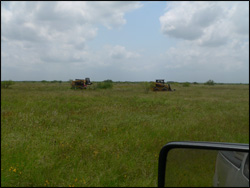 Coastal Prairie Conservation Initiative
Coastal Prairie Conservation Initiative
An Example of Cooperation and Conservation
By Brent Ortego and Arlene Kalmbach
I ndividual conservation groups and agencies attempted to restore the coastal prairie, but the scale of effort required usually resulted in a few hundred acres being restored at isolated locations. The first major habitat restoration efforts started with the formation of the Coastal Prairie Conservation Initiative (CPCI) in 1999. The CPCI focused the resources of multiple agencies in a planned effort to enlarge and connect blocks of existing coastal prairie. The CPCI is a good example of landscape scale habitat restoration partnerships between federal and state entities, private organizations, and private landowners to foster conservation on the ground at a scale that is meaningful to wildlife populations. The CPCI is a partnership of the Texas Parks & Wildlife Department (TPWD), The Nature Conservancy, U.S. Fish and Wildlife Service (USFWS), USDA Natural Resource Conservation Service, and Grazing Land Conservation Initiative pooling resources to assist private landowners retain family ownership, maintain historic values, profit from agriculture and conserve wildlife while achieving the collective goal of restoring and conserving the Coastal Prairie. The Landowner Incentive Program was the major funding mechanism in which TPWD participated in the CPCI.
In Texas the Landowner Incentive Program serves to assist private landowners to accomplish conservation goals through technical and financial assistance. The program got its start in Texas in 1998 then spent some years as a federally supported national program and is once again a state run effort in Texas. The program has worked to enhance and protect habitat for at-risk-species on over 250,000 acres across the state through partnerships with over 150 private landowners. Much of that conservation effort has been directed at work targeting the fragile ecosystems of the state's natural coastal prairies.
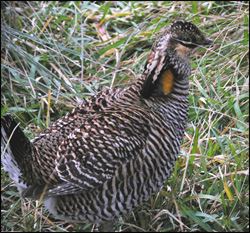
Conservation groups working to restore the Coastal Prairie recognized the imminent threat to the Attwater's Greater Prairie-Chicken (APC, Tympanuchus cupido attwateri), whose range is restricted to the coastal prairie, and historically contained about one million individuals on the coastal prairie (Lehmann 1968). APC populations declined as suitable habitat declined due to agricultural conversion, urban and industrial expansion, excessive grazing, invasion of the prairie by woody species and fragmentation of habitats (Lehmann 1941, Jurries 1979). Wild APC individuals on the coastal prairie declined to near zero in the early 1990's and the recovery of the species became focused on a captive rearing program to release birds back into the wild (United States Fish and Wildlife Service. 1996).
Conservation professionals began informally working together in 1999 by piecing together funding sources and target acreages to make the work less expensive to the landowners while positively impacting habitat on a landscape scale. Conservation groups formalized the CPCI with signed agreements between organizations in 2003. Regulatory relief in the form of federal Safe Harbor programs (http://library.fws.gov/Pubs9/safe_harbor_agree.pdf ) were obtained from the USFWS which assured landowners they would not incur any additional regulatory restriction if they improved their land for endangered species. Extensive efforts were made to demonstrate to landowners that the recommended practices would improve the profitability of their ranch and natural resources while at the same time preserving historic values.
The CPCI was successful in treating encroaching, invasive brush and improving infrastructure of ranches on 80,000 acres of private ranch land and made progress to connect isolated blocks of coastal prairie. A program to release APC back into private lands within the coastal prairie began in 2007 (Ortego et al. 2009).
The CPCI is successful because conservation groups were able to pool resources to meet common goals and objectives with willing landowners. The CPCI provided cost share assistance and technical expertise to improve coastal prairie habitat important to prairie wildlife while increasing ranch profitability. Prairie-chicken management had to be compatible with the goals for the ranch whether the landowner had an interest in the APC or not. The landowners would not tolerate additional regulatory burdens to benefit APC and the Safe Harbor reduced those concerns. Above all, the conservation effort needed to be accomplished without altering the landowner's life style, privacy and history. Today more than ever these critical coastal prairies face continuing threats but with partnerships like the CPCI we continue to see the progress and rewards of these restoration and conservation efforts.
Literature Cited:
Jurries, R. W. 1979. Attwater's Prairie Chicken. Texas Parks and Wildlife Department, Federal Aid Series No. 18, Austin, TX.
Lehmann, V. W. 1941. Attwater's Prairie Chicken, its life history and management. USFWS, North American Fauna Series 57.
Lehmann, V. W. 1968. The Attwater Prairie Chicken, current status and restoration opportunities. North American Wildlife Conference 33:398-407.
McKinney, L. B. 1996. Forty years of landscape change in Attwater's Prairie Chicken habitat within the coastal prairie of Texas. Thesis, Texas A&M University, College Station, TX.
Morrow, M. E., R. S. Adamcik, J. D. Friday, and L. B. McKinney. 1996. Factors affecting Attwater's Prairie-Chicken decline on the Attwater Prairie Chicken National Wildlife Refuge. Wildlife Society Bull. 24:593-601.
Ortego, B., M. Wagner, T. Anderson, W. Harrell, and C. Carter. 2009. Engagement of Texas private landowners in conservation. Proc. International Partners in Flight Conf. 4: 491-492
Smeins, F. E., D. D. Diamond, and C. W. Hanselka. 1991. Coastal prairie. Pages 269-290 in R. T. Coupland, editor. Ecosystems of the world 8. A-natural grasslands-introduction and western hemisphere. Elsevier Press, New York, New York, USA.
United States Fish and Wildlife Service. 1996. Attwater's Prairie Chicken species recovery plan. Region 2, Albuquerque, NM.
Brent Ortego is the Diversity Biologist with Texas Parks and Wildlife Department working out of Victoria, TX. Arlene Kalmbach is the Landowner Incentive Plan Coordinator with Texas Parks and Wildlife Department working out of Lincoln, TX.
There are currently about 90 Attwater's prairie-chickens in the wild. These can be found in three populations along the coastal prairie.
The Live Oak Motte
Important Habitat Emblematic of the Texas Coast
By John C. Arvin
The mottes are particularly important to the millions of migrating birds that pass through the Texas coastal region twice a year. They are of special importance in the spring when birds arriving from a non-stop flight across the Gulf may be drained of energy from bucking the headwinds and turbulent weather that usually accompany cold fronts. Under those conditions the oak mottes can literally mean the difference between life and death to exhausted songbirds that may have been on the wing for 18 to 24 hours. An oak motte can be virtually birdless during favorable weather for migration – that is with helping winds and fair skies. Under these conditions arriving migrants appear over the coast during midday and have plenty of reserves to continue flying until they are well inland before landing in the evening. On days with rain, thunderstorms, and strong headwinds a single oak motte may be an escape hatch, saving hundreds of birds' lives that otherwise would perish from exhaustion, dehydration, and predation to which their weakened condition renders them vulnerable. Under these conditions the motte may swarm with dozens to hundreds of birds of 30 or more species. With food-producing plants and the insects that feed on them to recharge their energy reserves, and the shelter provided by the interlacing oaks and understory shrubs these lucky travelers have a good chance to survive and reach their breeding grounds and to complete their life cycles.
Coastal mottes perform an important function in the lives of migratory birds in fall migration also, although it is not quite as dramatic as the role they play in spring. Southbound birds have a more leisurely migration, moving down the continent in a series of relatively short hops, stopping off for periods of time where resources are bountiful to fatten up. More birds take a path around the Gulf through Texas and Mexico in fall than in spring so when they reach the coast the mottes act as their stepping stones. For those that do make an overwater flight the motte is a last chance to "top off the tank" and be in peak condition for the crossing. The late summer-early fall period is one of plenty when fruit-bearing trees and shrubs, nectar producing native flowers, and insect populations peak.
Coastal live oaks are tough, and can stand up to most of the extremes of nature, including hurricanes. Indeed they help stabilize our coasts against such catastrophic events. However, they are not only attractive to migrating birds and other organisms for which they provide food and shelter. They also make attractive sites for people who want a little place on the coast where they can spend weekends and summer vacations. Many of the finest examples of coastal mottes have become home sites or RV parks. Others have succumbed to development of huge industrial plants which find coastal access vital to the movement of their raw materials and products.
Live oak mottes thrive on some of our public lands where they have been protected. Well developed mottes can be seen at Goose Island State Park and at Aransas National Wildlife Refuge on the central Texas coast. San Bernard National Wildlife Refuge and the Candy Abshier Wildlife Management Area at Smith Point on the upper coast have some well developed mottes also. According to historical accounts most of the live oaks on Galveston Island were planted in the early 20th century. One of the saddest results of Hurricane Ike's fury on the natural environment is the loss of hundreds of huge, century-old live oaks that formerly lined the streets of Galveston. The city was a virtual man-made oak motte.
Oak mottes are a very important habitat in our coastal environment. They should be valued, protected, and encouraged wherever they occur. Live oak acorns drop in the early fall, often in profusion. They begin to germinate soon after falling, so the acorns can be collected and planted right away to provide a source of seedlings for expanding existing mottes or creating new ones. The young trees grow relatively rapidly if provided with supplemental water. Why not think about establishing a motte in a suitable coastal area? It can be a great project for a local birding club, native plant association, or other nature-oriented group.
John is the Research Coordinator at Gulf Coast Bird Observatory in Lake Jackson, TX.
Such a Unique Creature
By Stan Mays
The Diamondback terrapin, Malaclemys terrapin, is a small to medium sized turtle found in salt marshes, estuaries, and tidal creeks. Its name is derived from the sculpted appearance of the carapace, which somewhat resembles the facets of a cut diamond. Most aquatic turtles are either strictly freshwater or marine, but not the terrapin. It is unique in being the only turtle species associated with waters of intermediate salinity. Consequently, it has special adaptations to survive in this environment that are not found in other turtles.
In terms of diet, the Diamondback terrapin can best be described as an opportunistic carnivore. Snails, crabs, shrimp, fish, clams and other items normally associated with a seafood restaurant menu have all been observed being consumed by terrapins.
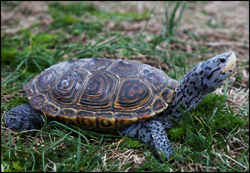
© USFWS
Diamondback terrapins range from Cape Cod all along the Atlantic and Gulf Coast into Texas. Although there are seven recognized subspecies, only one (littoralis) is found in Texas (Ernst et al., 1994), which ranges from western Louisiana along much of the Texas coast to the Corpus Christi area.
For many years, Diamondback terrapins were considered a culinary delicacy which almost brought about the extinction of many populations near metropolitan areas. In the late 1800's there was an active commercial fishery for terrapins in the Galveston area. The resulting overexploitation led to significant population declines which eventually led to the demise of this industry.
There have been a number of Diamondback terrapin studies on the Atlantic Coast, especially in the northern part of the turtle's range. Unfortunately, very little is known concerning the status of the Diamondback terrapin population in Texas. To date, only one study has been completed (Hogan, 2003) which concentrated mainly on surveying nesting areas and terrapin distribution in Galveston Bay. The exact population status is unknown, although it is felt to be declining due to a number of reasons such as habitat loss from human alterations, nest site disturbances, mortality from abandoned crab traps, and estuarine pollution. A number of animals, such as raccoons, birds, and crabs also routinely raid terrapin nests for eggs. It is estimated that up to one third of all terrapins accidentally caught in crab traps drown (Wood et al., 1995).
In the recently approved Texas Wildlife Action Plan (2005-2010): Comprehensive Wildlife Conservation Strategy produced by the Texas Parks and Wildlife Department, the Texas Diamondback terrapin was classified as a Medium priority species with federal G4 (Uncommon) and state S3 (Vulnerable) status and was considered a species of concern at both the federal and the state level. In many states where the Diamondback terrapin is found, the population status is either unknown or declining (Siegal et al., 1995). In the Action Plan, this species is also categorized as aquatic and has a number of problems listed for its ecoregion (coastal Texas). Distributional studies on its population are one of the conservation actions recommended in the Action Plan.
In an attempt to learn something about the Diamondback terrapin population around the Galveston Bay area, the Houston Zoo, in cooperation with the University of Houston Clear Lake (UHCL) and Texas Parks and Wildlife Department, began field work in November, 2007, on the Diamondback terrapin populations around North and South Deer Islands in Galveston Bay. Each animal collected was measured, sexed, marked by shell notching and injected with a PIT (Passive Integrated Transponder) tag for identification purposes. When possible, blood was drawn for genetic testing. Using the capture and recapture rates it should be possible to estimate the size of this population. So far, Houston Zoo employees, graduate students from UHCL working under Dr. George Guillen, and volunteers have amassed well over 1000 hours devoted to work on this study.
Terrapins are collected using two methods. The first is the simple hand capture of the animals as they swim or as they bask on land. In addition, crab traps that have been modified with chimneys (to minimize risk of animals drowning) are also being used.
Habitat preferences for Diamondback terrapins are also being quantified. Water and air temperature, salinity, pH, wind speed, cloud cover, substrate type and vegetative cover (on land) are all recorded at each capture. In addition, UHCL graduate students are attaching acoustic tags to some terrapins to determine their movements within the bay. External radiotelemetry tags are also being used to estimate home ranges, habitat use, dispersal, and other characteristics of this population. Finally, mortality of terrapins due to drowning in crab traps is being estimated during the yearly collection of unclaimed crab traps.
Why collect all this data? The Texas Diamondback terrapin is the least studied of all the seven species of terrapins found in the United States. Much remains to be discovered concerning its ecology and natural history. For example, very little is known concerning the juvenile life stage of a terrapin. Population surveys have been concentrated around the Galveston Bay region. Before a conservation action plan for this species can be implemented, it is important to know as much about the entire Texas population as possible. Population studies of terrapins should be expanded to include all areas of appropriate habitat along the coast of Texas and basic questions of the population dynamics and demographics should be answered. Only then can we make intelligent decisions that will insure the survival of this unique resident of our coastal areas.
Stan Mays is Curator of Herpetology at the Houston Zoo.
References:
Ernst, C.H., Lovich, J.E., and Barbour, R.W. 1994. Turtles of the United States and Canada. Smithsonian Institute.
Hogan, J.L. 2003. Occurrence of the Diamondback terrapin (Malaclemys terrapin littoralis) at South Deer Island in Galveston Bay, Texas, April 2001-May 2002. U.S. Geological Survey. Open-file report 03-022.
Siegal, R.A., and Gibbons, J.W. 1995. Workshop of the ecology, status, and management of the Diamondback terrapin (Malaclemys terrapin), Savannah River Ecology Laboratory, 2 August, 1994: Final results and recommendations: Chelonian Conservation and Biology vol. 1, no. 1, 240-243.
Wood, R.C., and Herlands, R. 1995. Terrapins, tires, and traps: Conservation of the Northern diamondback terrapin (Malaclemys terrapin terrapin) on the Cape May Peninsula, New Jersey, U.S.A.: International Congress of Chelonian Conservation, 254-256.
Gulf Coast Kangaroo Rat
Conservation and Research in Coastal Texas
By M. Clay Green
TThe Gulf Coast Kangaroo Rat belongs to the Family Heteromyidae in the Order Rodentia. In Texas, there are 13 species of heteromyids of which 5 species belong to the genus Dipodomys. The Gulf Coast Kangaroo Rat occurs throughout most of south Texas, from the fringes of Bexar, Caldwell, and Gonzales counties down thru the lower Rio Grande Valley and on the barrier islands, namely Padre and Mustang Island. The species inhabits sparsely vegetated, sandy soils of south Texas and the leeward side of dunes along the barrier islands. Currently, two subspecies of Dipodomys compactus are recognized, D. c. compactus on the barrier islands and D. c. sennettii on the mainland of Texas. While the species is listed as common throughout its range, increased urbanization and development along Mustang and Padre Island is cause for concern for this state and federal species of concern. Dipodomys compactus compactus is the only species of rodent listed as species of high concern by the Texas Wildlife Action Plan.
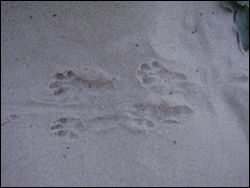
© Sean Rissel
The main reason for conservation concern with Gulf Coast Kangaroo Rats is habitat loss, however lack of information on the species distribution, resource selection, and genetic structure of the population add to the overall concern for this species. While the overall range of the species is mostly known, information on the distribution of the species within its range is lacking. It is unclear if D. c. compactus occurs on barrier islands north of Mustang Island and little is known about the spatial distribution of the species on North and South Padre Island. Previous studies from Padre Island on rodent diversity suggests that kangaroo rats are only found in small areas and do not occur uniformly along the 130 mile stretch of North and South Padre Island, even where suitable habitat appears to be available. As mentioned earlier, suitable habitat for Gulf Coast Kangaroo Rats appears to be sparsely vegetated sandy soils, although the mainland species has been reported on yellow-sand prairies of southeastern Texas and post oak-blackjack oak communities around Bexar County.
The taxonomic history of the Gulf Coast Kangaroo Rat is complex and not without controversy. In mainland Texas, the geographic distribution of the Gulf Coast Kangaroo Rat overlaps with that of Ord's Kangaroo Rat (Dipodomys ordii) from Atascosa and McMullen counties west to the Mexican border and south to the Lower Rio Grande Valley. Early research on kangaroo rats in south Texas suggested that all individuals occurring on the Texas mainland were Dipodomys ordii sennettii and individuals occurring on the barrier islands as D. Compactus. Because of the overlapping ranges in mainland south Texas, it has been suggested that potential mixing of specimens or misidentifications between the two species may have occur that has led to this taxonomic confusion. More contemporary research suggests that while D. compactus and D. ordii are closely related taxa and potentially comprise a sister clade, they are indeed two separate species and D. c. compactus and D. c. sennettii are valid subspecies. Karotypic data for the Gulf Coast Kangaroo Rat reveals that both subspecies have the largest number of chromosomes for the genus Dipodomys (2n = 74); Dipodomys ordii has 2n = 72 chromosomes. While separation between the two species and two subspecies of D. compactus appears valid, nothing is known about the overall genetic population structure of D. compactus and potential gene flow within and between the mainland sites and the barrier islands. This is critical information that is needed for the barrier islands in the wake of continued development along the coastal dune ecosystem.
"Over here, I think I found some tracks and several burrows" said Sean. Sure enough, as we topped the dune and walked down the leeward side of the dunes of Padre Island, we saw many burrows with the characteristic tracks of a 5-toed, kangaroo rat. Sean Rissel, a graduate student in the Wildlife Ecology Program, Department of Biology at Texas State University, initiated his field research in the spring of 2010 on Gulf Coast Kangaroo Rats. His main research goals are to estimate the distribution and abundance of Dipodomys compactus compactus within Padre Island National Seashore and to examine the macro- and microhabitat variables associated with the occurrence of this species. Sean is conducting live-trapping surveys and ear-marking of kangaroo rats on the dunes of Padre Island to obtain estimates of occupancy and abundance. He is also taking ear notches from individuals captured to use for future genetic analysis comparing individuals on North and South Padre Island and individuals from sites in south Texas. Like the rattlesnake that continues to elude us after our first encounter on the dunes, answers to the long-term outlook of Gulf Coast Kangaroo Rats on the barrier islands elude us still. However, it is our belief that the much needed attention now being paid to Texas' only rodent species of high concern, the knowledge gained from Sean's research and others will provide the information needed to better manage this species in the face of increasing habitat loss and changing climates.
Dr. Green is an Assistant Professor in the Department of Biology at Texas State University in San Marcos, TX.
Whooping Crane Comeback
By Amanda Diaz
To ensure the survival of the species, biologists attempted to introduce whooping cranes to other environments apart from the naturally migrating flock. A non-migratory flock was placed in Florida starting in 1993 along with an additional migratory flock started in 2001. A multi-partied group called the Whooping Crane Eastern Partnership created a migratory flock by using ultralight aircraft to teach young whooping cranes how to fly from Necedah National Wildlife Refuge in central Wisconsin to western Florida. As of September 2010, this flock had 96 whooping cranes migrating in the eastern U.S. While these flocks have made significant progress, they are not self-sustaining and the non-migratory reintroduction in Florida has been stopped. They currently do not provide the safeguards needed for species recovery.
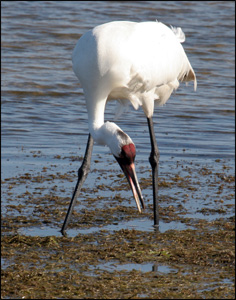
© Steve Sykes
The natural migratory flock wintering in Texas has seen the most growth, totaling 263 whooping cranes in spring 2010. These cranes travel twice a year an astounding 2,500 miles from Wood Buffalo National Park in the boreal forest of Canada to the Texas coastal prairie of Aransas.
The success of the whooping crane is encouraging but the species has endured many struggles, most recently a devastating South Texas drought in 2008. The fragile coastal ecosystem became an inhospitable environment for wildlife, namely the blue crab. This crab is the main staple of a whooping cranes diet, with an adult crane able to eat as many as 80 blue crabs in a day.
Due to the severe drought and reduced inflows, the salinity levels in the bay and marshes skyrocketed, rendering a depleted supply of marsh life for the cranes to feed on. The birds began scouring the surrounding habitat for sustenance, forcing them onto uplands. The hardships resulted in multiple deaths during the 2008 winter season. In an effort to thwart further loss, an emergency feeding plan was put in place. Whole-kernel corn was distributed between 13 game feeders throughout the Aransas National Wildlife Refuge beginning in January 2009 and continuing until the birds migrated in April.
Despite ongoing effort to supply the whooping cranes with food, a total of 23 birds were lost during the 2008-2009 winter season, the largest population decline ever seen at Aransas.
Fortunately last winter, the drought ended and the whooping cranes required no assistance in finding nourishment. Rainfall in South Texas starting in September 2009 revived the coastal prairies, wetlands and marshes allowing the cranes to recover from the previous harsh winter.
This year's nesting season saw a high success rate with 46 chicks fledged from a record 74 nests in Wood Buffalo. Here in Texas, blue crab populations have rebounded and lower salinities have revitalized the marshes so the whooping cranes are expected to fare well in the coming winter. The total of whooping cranes in the wild and in captivity, all located in North America, currently numbers 536.
The current whooping crane population is spread out over 65,000 acres of salt marsh along a 36-mile stretch of the Texas coast. To reach a down-listing target of 1,000 cranes, an additional 125,000 acres of crane habitat needs to be protected. This habitat includes upland areas next to the marshes, some of which are threatened by development. A major conservation effort is urgently needed to further protect coastal marshes and prairies to allow the whooping crane to continue its remarkable comeback.
All of the whooping cranes at Aransas National Wildlife Refuge migrate each year from Wood Buffalo National Park in Canada's Northwest Territories.
Amanda Diaz is with the United States Fish and Wildlife Service at Aransas National Wildlife Refuge.
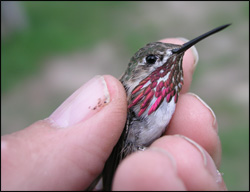
Calliope Hummingbird
Winter Hummingbird Study
Produces Hidden Jewels on the Texas Coast
By Brent & Sue Ortego
We conducted a winter hummingbird study at our bird banding station near Victoria, TX. The site generally supported about 100 individuals each winter from 8 species on a 6-acre suburban property. The banding station borders the floodplain of Coleto Creek and has some riparian woodlands at the lower elevations, live oak covered lawn with over 100 feet of flower beds on the high end, and a mixture of bull mesquite and dense saplings/vines on the remainder of the property.
Banding in this area started as opportunistic activities to learn more about birds and later expanded as it was found the site had great potential for monitoring hummingbirds and songbirds. The net result was 47,000 birds were banded along with 21,000 recaptures of 161 species since 1993. Hummingbirds represented 44% of the banded birds. Captures per winter varied with a high of 160 hummingbirds to a low of 76. These winter captures of hummingbirds were the highest reported in the eastern United States.
Data from the site indicated that hummingbird density was directly related to number of feeders. We started with 12 feeders and typically captured about 12 hummingbirds each winter for 4 years. We then progressively increased the number of feeders over another 4-year period and the number of hummingbirds over-wintering consistently increased with feeder numbers. We finally reached a limit of the number of feeders we were willing to maintain at 75 and caught over 100 hummingbirds most winters.Many wintering hummingbirds at the site survived and returned during following years. The make up of hummingbirds each winter typically comprised of 40% returnees from previous years. It was not unusual to have a hummingbird return for 3 or more winters. Record longevity/site fidelity for individual birds at the banding station was 11 years for Buff-bellied, 8 for Black-chinned, 6 for Rufous, 4 for Ruby-throated, and 3 for Allen's and Calliope.
Habitat management for hummingbirds throughout Texas mostly involves discussions of flower beds and feeders in landscaped yards. It seldom involves looking at habitats used by the birds. Our banding station was unique in that most of the birds preferred to be in native habitat rather than the classical managed landscape for hummingbirds (flower beds/lawns). We examined frequency of 4 major habitats on the property to try to determine which sites were used at greater rates in this setting of very high winter hummingbird density and constant fighting amongst individuals and species. At peak density, we were over-wintering 26 hummingbirds per acre of habitat.
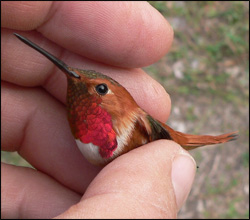
Rufus Hummingbird
Habitats were categorized as Willow which was a riparian woodlands of multi-layered forest, Live Oak as open lawns, flower beds and tree canopy, Mesquite as large old-growth mesquite with dense native ground cover and little mid-story, and Brush which was a dense sapling/brush/vine tangle generally less than 10 feet in height. All habitats contained a grid of trails spaced at 10 by 40 yard intervals, had uniform hummingbird feeder density which was generally one feeder per 10 yards of trail within the habitat.
We documented winter habitat use for 285 Buff-bellied Hummingbirds, 147 Rufous Hummingbirds, 90 Black-chinned Hummingbirds, 39 Ruby-throated Hummingbirds, 25 Allen's Hummingbirds, 20 Broad-tailed Hummingbird, and 19 Calliope Hummingbirds from 2000 thru 2006. Buff-bellied was the most abundant, largest and most aggressive species and tended to occupy all habitats at uniform density. Rufous showed a higher percent of use for Brush habitats and less use of the forested, park-like settings. Black-chins tended to use the forested park-like settings at higher rates, Ruby-throats tended to be caught at higher rates in the Live Oak/lawn/flower bed setting than the other habitats. Allen's avoided the park-like forested settings and were mostly found in dense vegetation. Broad-tails and Calliope were primarily found in Brush settings. Anna's and Broad-billed occurred too infrequently to interpret habitat use.
While we managed extensive flower beds to attract hummingbirds to our yard (Live Oak setting), by far the greatest densities of birds occurred in adjoining native habitats comprised of dense brush, vines and saplings. This Live Oak setting was typically what most landowners provided as hummingbird habitat, and had a normal component of feeders and over 100 feet of flower beds dominated by shrimp plant which is a great winter bloomer. The other habitats at the banding station had no flowers during winter. They seasonally had large numbers of flowers from spring through fall depending on rainfall. This Live Oak site was only most frequently used by Black-chinned and Ruby-throated during winter. Brush less than 10 feet in height with varied structure, but high density of vegetation appear to be important for Calliope, Rufous and Allen's Hummingbirds at this site. Dense, early successional stage saplings/brush/vines are seldom managed for hummingbirds, but should be given serious consideration.
We have shown through this study that relatively high densities of a diverse array of hummingbird species can be maintained through the winter near the Gulf Coast, hummingbirds have a strong site fidelity and will live much longer than previous expected.
Brent is the diversity biologist for Texas Parks and Wildlife Department in Victoria, TX
Shawn Ashbaugh, Susan Beree, Charlie & Olivia Brower, Brad Lirette, Robert & Kay Lookingbill, Sumita Prasad, Bron Rorex, Suzie Ross, Glenn Swartz, Craig Zalk assisted in banding.
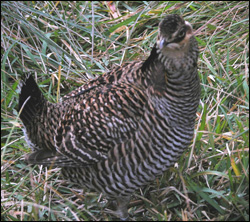 The Plight of the Beautiful Prairie Dancer
The Plight of the Beautiful Prairie Dancer
By Mark Klym
Opening the windows of the blind, we found ourselves surrounded by about a dozen Attwater's Prairie Chickens – males being obvious on the short grass of the lek and females just beyond sight in the taller grass of the prairie.
This beautiful morning was seven years ago. Today storms, encroaching urbanization and other threats have brought this population, one of three currently found on the coastal prairie, to a perilously low count. This is not the situation at the other two populations though – one in Colorado County and the other in Goliad County.
The Attwater's Prairie Chicken, a grouse of the coastal prairie of Texas, is a subspecies of the Greater Prairie Chicken. They once roamed the coastal prairie from Louisiana at least around to Kingsville with some reports showing them as far south as Brownsville. Today the estimated population of 90 birds is spread between three isolated populations in three distinct counties – the population I visited in Galveston County, one in Colorado County and a third in Goliad County. Today's population is however a considerable increase over the 40 birds reported just five years ago.
While the Attwater's Prairie Chicken has a long way to go to recovery, the positive movement is encouraging. Much of this momentum can be attributed to the captive breeding efforts of zoos and other wildlife centers across Texas. These facilities have bred and raised these birds for release into the wild, increasing the annual release from a few birds to about 145 birds identified for release into the wild this year. While one would think this number would make a sizeable jump in the population next spring, this bird is a prey species that historically relied on huge reproduction and recruitment numbers to maintain a stable population.
There has been progress on the prairies themselves too. At the Goliad County site, one hen still had one chick 6.5 weeks after hatch, while at the Colorado County site a conservative estimate of 58 chicks were observed at 6 weeks post hatch this year.
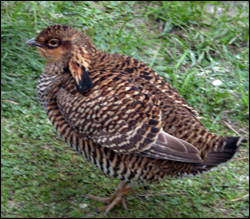 Another significant factor in the upward momentum of these population numbers is habitat restoration and protection. Attwater's Prairie Chicken relies heavily on native "bunch grass" prairie. Much of the 9,500,000 acres that were once coastal prairie is now Houston, Galveston, Corpus Christi and other urban areas. Large patches have also been converted to rice, cotton and other cultivated crops. Huge swaths have become Chinese Tallow forests and others mesquite brush. The combined threat of human activities has left less than 1% of this prairie intact. Efforts to restore these areas have included a diverse team including federal, state and county governments, non-governmental organizations and land-owner groups working together to remove exotic and invasive species and restore, protect and encourage native growth.
Another significant factor in the upward momentum of these population numbers is habitat restoration and protection. Attwater's Prairie Chicken relies heavily on native "bunch grass" prairie. Much of the 9,500,000 acres that were once coastal prairie is now Houston, Galveston, Corpus Christi and other urban areas. Large patches have also been converted to rice, cotton and other cultivated crops. Huge swaths have become Chinese Tallow forests and others mesquite brush. The combined threat of human activities has left less than 1% of this prairie intact. Efforts to restore these areas have included a diverse team including federal, state and county governments, non-governmental organizations and land-owner groups working together to remove exotic and invasive species and restore, protect and encourage native growth.
Finally, as habitat has been restored, agreements reached with the federal government to hold landowners safe from repercussion if released birds failed to thrive have made it more appealing to landowners to allow the release of these birds on their lands. One of the populations mentioned above is on private land, and as the production of captive birds increases and more birds are available for release, more private land will be needed to release these birds on.
So don't give up on the beautiful prairie dancer! You can help by supporting the Adopt-a- Prairie-Chicken program though the non-game fund at Texas Parks and Wildlife Department. Annual donations help with raising and releasing these birds. With your help, the eerie booming of the Attwater's Prairie Chicken will always be heard on the coastal prairie.
Mark Klym is coordinator of the Adopt-a-Prairie Chicken program with Texas Parks and Wildlife Department working out of Austin, TX.
 The Back Porch
The Back Porch
Coastal Prairie and Post Oak Savannah
By David Forrester
We as state biologists work with a lot of landowners interested in preserving or enhancing what native habitat they do have. There are numerous recommendations or suggestions that can be made depending on the condition of the habitat and the goals of the landowner. Our recommendations run the gamut. Some situations call for the complete re-establishment of native grasses. Many times the landowner may need to alter the stocking rates and grazing intensity on his/her property. In almost every situation, however, there is a recommendation to introduce fire as a management tool.
Most people think that fire on the landscape is a bad thing. Fire can destroy homes, livestock, fences, and structures. When most people look at an area that has been burned, they see a blackened picture devoid of vegetation or wildlife. Most of us see the sad baby bear, a tear tracking down one cheek, and hear "only you can prevent forest fires." There are no doubts a wild fire that threatens home and welfare is something we want to avoid, but there are some awesome benefits that can be realized from prescribed fires.
Most of Texas evolved with fire as part of the natural system. Many of the plants around us respond favorably to periodic fires. Before European man became dominant on the landscape, periodic fires kept the prairies open and brush species were not nearly as abundant as they are now. Fire consumed the thatch that develops on the prairie grass landscape, exposing the bare soil underneath to sunlight, thus promoting the germination of different annuals. There was also a fertilizer effect on the grass making it much more palatable and higher in quality.
This is not just a tool for those interested in wildlife management, but livestock producers can benefit from it also. As mentioned above, all grasses respond favorably to certain fires whether it is native grasses or improved pastures. Palatability and protein content can increase in grasses after a fire. There are numerous studies showing the increased protein content of forage post-fire and the increased gains in livestock grazing forage after a burn.
We can realize these same benefits from fire today by employing this tool under certain parameters or prescribed conditions. Prescribed burning is one of the most cost effective tools a landowner or manager has in his tool box, if he is interested in brush control, increasing plant diversity, and increasing grass and plant nutritional value. Price the cost of herbicides and application to control brush or other invasive species. Price the cost of mechanical means such as dozer work. The cost to create fire breaks, equipment to conduct a prescribed burn, and manpower makes prescribed burning a comparatively cheap alternative.
The key is knowledge of the safe parameters or conditions in which to implement a prescribed burn. Although a fire escaping is always a huge concern, with today's increased population, smoke management should also be foremost on the minds of landowners initiating a prescribed burn.
If you are interested in learning more about prescribed burning or trying to incorporate burning in your habitat management toolbox, there should be some prescribed burning workshops/seminars available in your area over the course of this winter. Texas Parks and Wildlife, the NRCS, and Texas AgriLife Extension promote this tool for habitat management and range management, and there should be local education/training opportunities. Over on the west side off my "back porch" there is the Coastal Bend Prescribed Burn Association that puts on educational trainings and actual prescribed burning opportunities. You can find more information at http://www.prescribedburn.org/. Additionally, you can call the TPWD District 7 office in La Grange, TX at 979-968-6591.
David Forrester is the District Leader for District 7 working out of LaGrange, Texas.

 Texas Parks and Wildlife Department, 4200 Smith School Road, Austin, TX 78744
Texas Parks and Wildlife Department, 4200 Smith School Road, Austin, TX 78744


